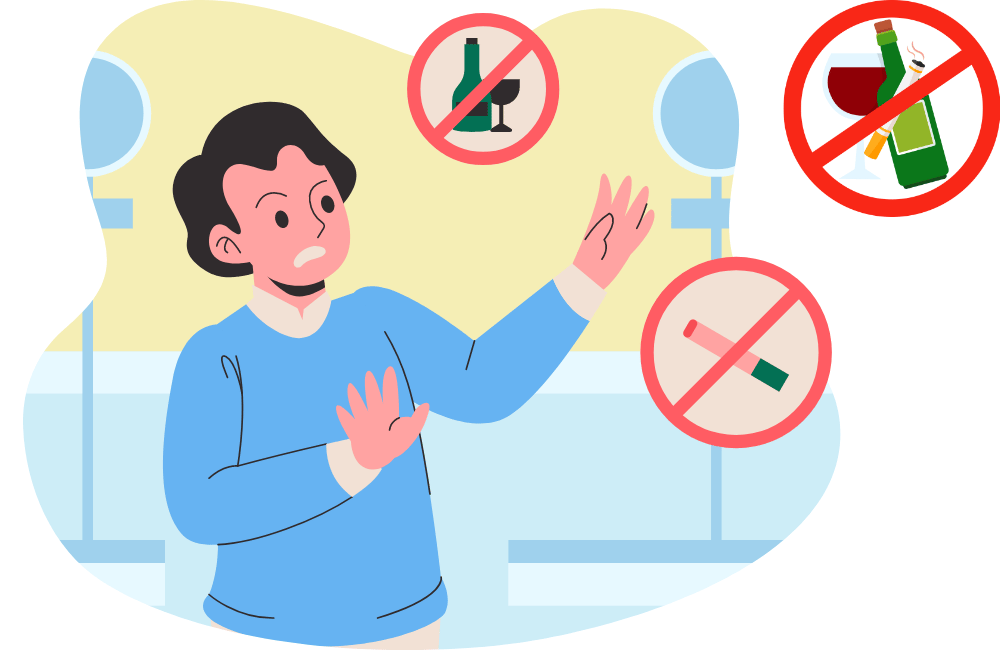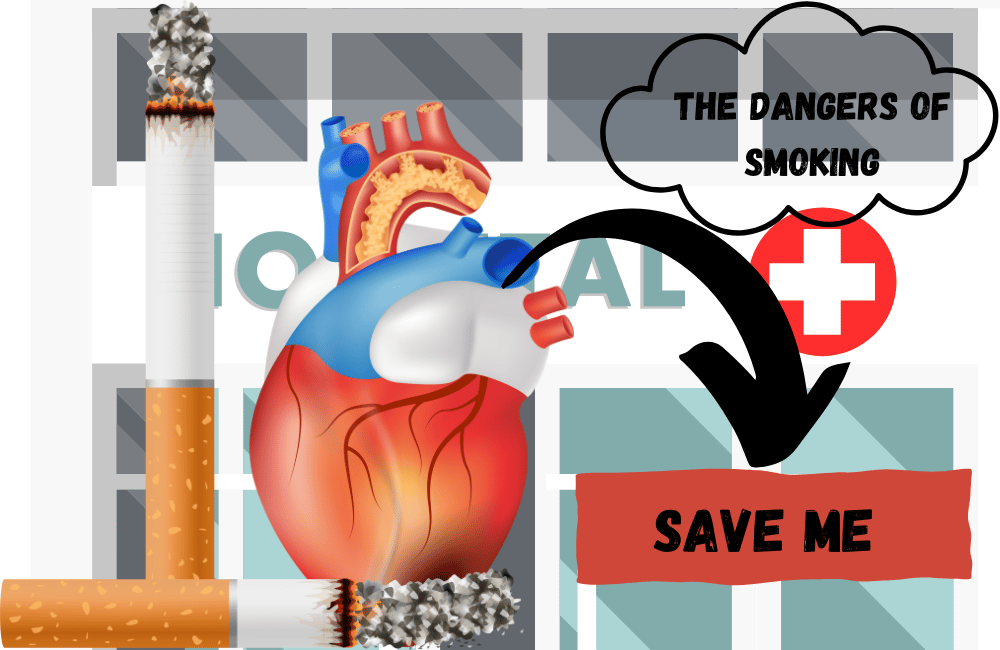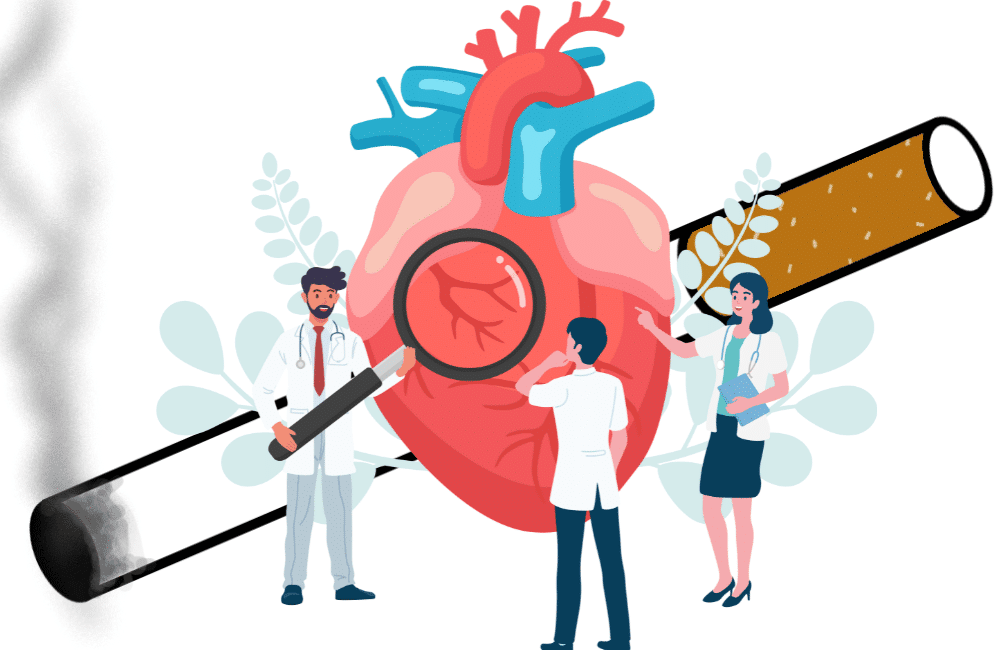Maintaining a healthy lifestyle is crucial for our overall well-being. Two habits that significantly impact our health are smoking and alcohol consumption. Smoking poses numerous risks to our respiratory system, while excessive alcohol intake can harm various organs.

In this article, we will explore the importance of avoiding smoking and limiting alcohol, exploring their harmful consequences on our health. Let’s uncover the facts and discover effective strategies to break free from these unhealthy habits.
The Dangers of Smoking
Smoking is a habit that poses significant dangers to smokers and those exposed to secondhand smoke. The detrimental effects of smoking extend to various aspects of our health, particularly the respiratory system, cardiovascular health, and overall well-being.

The Effects of Smoking on the Respiratory System: Smoking damages the lungs and leads to respiratory diseases. When inhaled smoke, it contains thousands of harmful chemicals that can cause severe damage to the delicate tissues of the respiratory system. The toxic substances in cigarette smoke irritate and inflame the airways, leading to various respiratory conditions. Chronic smoking can result in:
- Chronic Obstructive Pulmonary Disease (COPD): COPD is a progressive and debilitating lung disease that includes chronic bronchitis and emphysema. Smoking is the primary cause of COPD, resulting in a persistent cough, wheezing, shortness of breath, and reduced lung function.
- Chronic Bronchitis: Smoking irritates the bronchial tubes, causing chronic bronchitis. This condition is characterized by a persistent cough, excessive production of mucus, and recurring respiratory infections.
- Emphysema: Emphysema occurs when the air sacs in the lungs become damaged and lose their elasticity. Smoking-induced emphysema leads to difficulty breathing, coughing, and reduced lung oxygen exchange. The increased risk of lung cancer and other respiratory disorders:
- Lung Cancer: Smoking is the leading cause of lung cancer, accounting for most cases. The harmful chemicals in tobacco smoke, such as carcinogens, damage the DNA in lung cells and lead to the uncontrolled growth of abnormal cells. Lung cancer is a deadly disease with a low survival rate, making prevention through smoking cessation critically important. In addition to lung cancer, smoking increases the risk of other respiratory disorders, including:
- Pneumonia: Smoking weakens the immune system and damages the cilia in the respiratory tract, increasing the likelihood of developing pneumonia, a serious lung infection.
- Tuberculosis (TB): Smokers are more susceptible to developing tuberculosis, a bacterial infection that primarily affects the lungs. Smoking weakens the immune system, making it harder for the body to fight off the TB bacteria.
Smoking and Cardiovascular Health
Smoking has a detrimental impact on the cardiovascular system, increasing the risk of various heart and circulatory conditions:

The Correlation Between Smoking and Heart Disease
Smoking is a major risk factor for heart disease. The harmful chemicals in tobacco smoke, such as nicotine and carbon monoxide, damage the blood vessels, affecting their ability to function properly. The detrimental effects of smoking on the cardiovascular system include:
- Narrowing of blood vessels: Smoking causes a build-up of fatty deposits in the arteries, leading to atherosclerosis. The narrowed blood vessels reduce blood flow, increasing the risk of heart attacks and other cardiovascular events.
- Increased blood pressure: Smoking raises blood pressure, putting additional strain on the heart and increasing the risk of heart disease and stroke.
Smoke Effects
The harmful effects of smoking on blood vessels and the heart
- Increased risk of blood clots: Smoking promotes the formation of blood clots, which can block blood flow to the heart, brain, or other vital organs, resulting in heart attacks or strokes.
- Reduced oxygen supply: The toxic chemicals in cigarette smoke, such as carbon monoxide, bind to red blood cells, reducing their capacity to carry oxygen. This leads to a decreased oxygen supply to the heart, increasing the risk of heart-related complications.
Risks
- Increased risk of stroke: Smokers have a significantly higher risk of experiencing a stroke, which occurs when the blood supply to the brain is disrupted. Smoking contributes to the formation of blood clots and the development of atherosclerosis, increasing the likelihood of stroke.
- Higher incidence of heart attacks: Smoking damages the coronary arteries, which supply blood to the heart. This damage, coupled with the increased risk of blood clots, elevates the chances of experiencing a heart attack.
- Peripheral artery disease (PAD): PAD refers to the narrowing of blood vessels in the limbs, usually the legs. Smoking is a significant risk factor for PAD, as it contributes to the development of atherosclerosis in peripheral arteries, resulting in reduced blood flow and pain in the affected areas.
The Impact of Smoking on Overall Health
Smoking is not limited to damaging the respiratory system and cardiovascular health; it has a detrimental impact on overall well-being:

Smoking is a contributing factor to various types of cancers
- Besides lung cancer, smoking is a known cause of many other types of cancer, including those of the mouth, throat, esophagus, pancreas, bladder, kidney, cervix, and stomach. The toxic substances in tobacco smoke damage DNA and lead to the development of cancerous cells in various parts of the body.
Weakening of the immune system and increased susceptibility to infections
- Smoking weakens the immune system, making individuals more susceptible to infections. The harmful chemicals in cigarette smoke impair the function of immune cells, reducing their ability to fight off bacteria and viruses. Smokers are more prone to respiratory infections, such as pneumonia and bronchitis, as well as other infections throughout the body.
Premature aging and negative effects on skin health
- Smoking accelerates the aging process and negatively affects the health and appearance of the skin. The toxic chemicals in cigarette smoke damage collagen and elastin, essential components of healthy skin, leading to wrinkles, sagging skin, and a dull complexion. Smoking also reduces blood flow to the skin, depriving it of vital nutrients and oxygen.
Limiting Alcohol Consumption
Understanding Safe Alcohol Limits
To maintain a healthy lifestyle, it is essential to understand and adhere to safe alcohol consumption limits. These guidelines help individuals enjoy alcohol responsibly without jeopardizing their health.
Guidelines for Moderate Alcohol Consumption for Men and Women
Moderate alcohol consumption is generally defined as follows:
- For men: Up to two standard drinks per day.
- For women: Up to one standard drink per day.
It’s important to note that these guidelines may vary based on factors such as body weight, metabolism, and overall health. Some individuals may need to consume less or avoid alcohol altogether due to certain medical conditions or medication use.
The Definition of a Standard Drink and Its Alcohol Content
A standard drink is a unit of measurement used to quantify the amount of pure alcohol consumed. In the United States, a standard drink typically contains about 14 grams (0.6 ounces) of pure alcohol. However, it’s important to note that alcohol content may vary depending on the type of beverage.
Here are some examples of one standard drink:
- 12 fluid ounces (355 milliliters) of regular beer (5% alcohol content).
- 5 fluid ounces (148 milliliters) of wine (12% alcohol content).
- 1.5 fluid ounces (44 milliliters) of distilled spirits or liquor (40% alcohol content).
The Risks Associated With Heavy or Binge Drinking
Excessive alcohol consumption, particularly heavy or binge drinking, can have severe health consequences. Heavy drinking generally means consuming more than the recommended moderate alcohol limits.
The risks associated with heavy or binge drinking include.
- Liver Diseases: Prolonged and excessive alcohol consumption can damage the liver and increase the risk of developing conditions such as alcoholic hepatitis, alcoholic fatty liver disease, cirrhosis, and liver cancer.
- Alcohol-Related Gastrointestinal Issues: Heavy alcohol intake can irritate and inflame the lining of the stomach and intestines, leading to gastritis, ulcers, and gastrointestinal bleeding. In severe cases, it can cause pancreatitis, which is pancreas inflammation.
- Increased Susceptibility to Certain Cancers: Alcohol consumption has been linked to an increased risk of several types of cancer, including mouth, throat, esophageal, liver, breast, and colorectal. The risk is dose-dependent, meaning that the more alcohol consumed, the higher the risk.
Alcohol and Mental Health
The relationship between alcohol abuse and mental health disorders.
Excessive alcohol consumption can significantly impact mental health and contribute to developing or exacerbating various mental health disorders. While alcohol is initially often sought as a coping mechanism for stress or emotional distress, it can lead to a range of mental health issues, including:
- Depression: Alcohol can act as a depressant, affecting neurotransmitters in the brain and exacerbating symptoms of depression. Prolonged alcohol abuse can increase the risk of developing or worsening depressive episodes.
- Anxiety: While alcohol may temporarily alleviate feelings of anxiety, it can ultimately increase anxiety levels and contribute to the development of anxiety disorders. Regular and excessive alcohol use disrupts the balance of chemicals in the brain, leading to increased anxiety symptoms.
- Substance Abuse and Addiction: Alcohol abuse can lead to substance abuse and addiction, characterized by a loss of control over alcohol consumption and the inability to function without it. Substance abuse and addiction can severely affect mental health, well-being, and relationships.
Alcohol’s Impact on Cognitive Function and Memory
Excessive alcohol consumption can impair cognitive function and short-term and long-term memory. Alcohol affects the brain by interfering with neurotransmitters and the communication between brain cells. This can result in:
- Impaired Cognitive Function: Alcohol can affect concentration, decision-making abilities, and problem-solving skills. It can also lead to slowed reaction times, decreased coordination, and difficulty processing information.
- Memory Problems: Excessive alcohol consumption can cause blackouts, where individuals have gaps in their memory and cannot recall events that occurred during periods of intoxication. Chronic alcohol abuse can lead to long-term memory problems and cognitive decline.
Strategies for Quitting Smoking and Reducing Alcohol Intake
Quitting Smoking
The benefits of quitting smoking and the positive effects on health:
Quitting smoking is one of the most important steps individuals can take to improve their health and well-being. The benefits of quitting smoking include:
- Reduced Risk of Health Issues: Quitting smoking lowers the risk of developing various respiratory diseases, cardiovascular diseases, cancers, and other smoking-related illnesses.
- Improved Respiratory Function: Quitting smoking allows the lungs to heal, improving breathing capacity, reducing coughing, and enhancing overall respiratory function.
- Better Cardiovascular Health: Quitting smoking significantly reduces the risk of heart disease, stroke, and other cardiovascular conditions. The risk decreases progressively over time after quitting.
Creating a Support System and Seeking Professional Help
Quitting smoking can be challenging, but success is achievable with the right support and resources. Strategies to quit smoking include:
- Building a Support System: Inform family, friends, and colleagues about your decision to quit smoking and seek their support. Joining support groups or online communities can provide additional encouragement and advice.
- Seeking Professional Help: Healthcare professionals can provide guidance and support throughout quitting. They can recommend smoking cessation medications, nicotine replacement therapies (such as patches or gums), or behavioral counseling to enhance the chances of quitting successfully.
Smoking Cessation Methods: NRT and Counseling
- Nicotine Replacement Therapy (NRT): NRT provides a controlled dose of nicotine without the harmful toxins in cigarette smoke. It helps reduce cravings and withdrawal symptoms during the quitting process. NRT options include nicotine patches, gums, lozenges, nasal sprays, and inhalers.
- Behavioral Counseling: Behavioral counseling can help individuals identify triggers and develop coping mechanisms to overcome cravings and manage stress without turning to smoking. Counseling sessions can be conducted individually or in group settings.
Reducing Alcohol Intake
Setting realistic goals and creating a personalized plan
Reducing alcohol intake requires setting achievable goals and creating a personalized plan to limit consumption. Strategies for reducing alcohol intake include:
- Goal Setting: Start by setting realistic goals for alcohol consumption. This may involve gradually reducing the number of days or alcohol consumed weekly.
- Tracking Consumption: Record the amount of alcohol consumed to raise awareness of drinking habits and identify opportunities for reduction.
Seeking support through therapy, support groups, or counseling
Reducing alcohol intake can be challenging, and seeking support from professionals or support groups can be beneficial. Strategies for seeking support include:
- Therapy or Counseling: Consider seeking therapy or counseling to address underlying emotional or psychological factors contributing to excessive alcohol consumption. Therapists can help develop coping strategies and provide guidance on healthier ways to manage stress.
- Support Groups: Joining support groups, such as Alcoholics Anonymous (AA) or other recovery programs, provides individuals with a supportive community of people going through similar experiences.
Finding alternative activities and developing healthier coping mechanisms
Finding healthy alternatives to alcohol can help individuals reduce their reliance on drinking. Strategies include
- Engaging in Hobbies and Activities: Find activities that bring joy and fulfillment, such as exercising, painting, gardening, or engaging in social events that do not revolve around alcohol.
- Healthy Stress Management: Develop healthier coping mechanisms for stress, such as practicing mindfulness, meditation, yoga, or deep breathing exercises. Engaging in regular physical activity can also help manage stress levels.
The Path to a Healthier Lifestyle
Embracing a Balanced Diet and Regular Exercise
A balanced diet and regular exercise are essential components of a healthy lifestyle. Strategies to achieve a balanced diet and incorporate exercise include:
- Balanced Diet: Focus on consuming various nutrient-rich foods, including fruits, vegetables, whole grains, lean proteins, and healthy fats. Limit processed foods, sugary snacks, and saturated fats.
- Regular Exercise: Regular exercise that suits your fitness level and preferences. This can include activities such as walking, jogging, swimming, cycling, or participating in group fitness classes. Aim for at least 150 minutes of moderate-intensity weekly aerobic activity and strength training exercises.
Stress Management Techniques
Effective strategies for managing stress without turning to smoking or alcohol
Stress is a common trigger for smoking and alcohol consumption. Developing healthy stress management techniques is crucial for maintaining a balanced lifestyle. Strategies for managing stress include:
- Mindfulness and Meditation: Practice mindfulness and meditation techniques to promote relaxation and reduce stress. This can involve focusing on the present moment, deep breathing exercises, or guided meditation sessions.
- Relaxation Techniques: Explore different relaxation techniques such as taking warm baths, practicing yoga or tai chi, listening to calming music, or engaging in hobbies that promote relaxation.
Seeking Professional Help and Regular Health Check-ups
The significance of regular health check-ups and screenings
Regular health check-ups and screenings are vital in maintaining overall health and well-being. Regular visits to healthcare professionals allow one to assess health status, detect potential issues early on, and receive personalized advice and guidance.
Consulting healthcare professionals for personalized advice and guidance
Healthcare professionals, including doctors, nurses, and specialists, are valuable resources for personalized advice and guidance on maintaining a healthy lifestyle. They can provide information specific to individual needs, offer support in quitting smoking or reducing alcohol consumption, and help navigate the path to improved well-being.
Final Thoughts
Avoiding smoking and limiting alcohol consumption are crucial steps towards achieving a healthy lifestyle. The risks associated with smoking, such as respiratory diseases and cancer, highlight the importance of breaking free from this harmful habit. Likewise, excessive alcohol intake can lead to various health complications, including liver diseases and mental health disorders. By implementing strategies for quitting smoking and reducing alcohol consumption, combined with a balanced diet, regular exercise, stress management techniques, and seeking professional help, we can pave the way for a healthier and happier life. Let us prioritize our well-being by making informed choices and taking control of our habits today.

